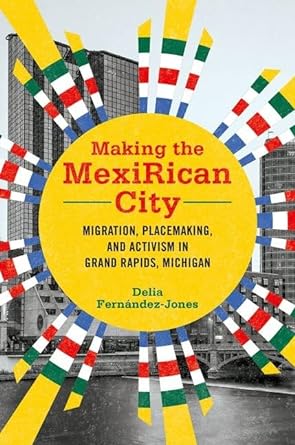Making the MexiRican City: Migration, Placemaking, and Activism in Grand Rapids, Michigan

Grand Rapids, Michigan, also known as “Furniture City,” is a center of office furniture manufacturing and a thriving craft beer industry, and is home to regional supermarket chain Meijer, international multilevel marketing company Amway, and several Christian book publishers. Notable residents include former U.S. Secretary of Education Betsy DeVos (daughter-in-law of Amway co-founder Richard DeVos) and former President Gerald Ford, whose presidential museum and final resting place are also in Grand Rapids. In other words, as Delia Fernández-Jones writes in the opening pages of Making the MexiRican City, Grand Rapids has historically been “probusiness, religiously conservative, and overwhelmingly white” (3).
Yet, since the 1920s Grand Rapids has also been home to a Latina/o population—primarily Mexican, Mexican American, and Puerto Rican during the years of Fernández-Jones’ study (1920s-1970s)—that continues to grow and diversify. Given the particulars of Grand Rapids history, she argues that the Grand Rapids Latina/o community “exemplifies how a numerical minority with limited resources can transform an indifferent, at times hostile, locale into a setting that meets their material and cultural needs” (3). She further argues that Latina/o placemaking and activism in Grand Rapids, methods necessary to make the city livable for the Latina/o community, are demonstrative of the ways by which “Latinos across the country, in areas urban and rural, both small and large, have had to organize to ameliorate their conditions” (3).
The book is structured along three themes: Latina/o migration to Grand Rapids from the 1920s to the 1960s; Latina/o placemaking practices from the 1940s to the 1970s; and Latina/o activism from the 1960s to 1978. In her first chapter, Fernández-Jones traces the paths by which Mexican nationals, Mexican Americans from Texas, and Puerto Ricans arrived in Grand Rapids between the 1920s and 1960s. She contextualizes Latina/o migration to Grand Rapids through discussion of conditions in Mexico, Texas, and Puerto Rico that drove many to seek better opportunities elsewhere, as well as the factors that made the Midwest, and Grand Rapids particularly, a desirable destination.
She then considers how familial networks both encouraged Latina/o settlement in Grand Rapids and offered a support system for new arrivals, particularly in terms of employment and housing. This support network was crucial within the racial order of Grand Rapids where the white majority viewed Latina/os as neither Black nor white, but as foreign and “part of an in-between group that should be denied access to the privileges possessed by white Grand Rapidians” (44). Fernández-Jones argues that from the early 1940s to the late 1950s these dynamics placed Mexicans and Puerto Ricans in frequent contact, which “built and reinforced networks and began the process of building pan-Latino solidarity” (40-41).
The theme of pan-Latino solidarity is explored further through an examination of Latina/o placemaking in Grand Rapids in the religious and recreational spaces shared by Mexicans and Puerto Ricans. Though the forging of solidarity was not always seamless, Fernández-Jones notes that shared spaces also led to interethnic marriages between Mexicans and Puerto Ricans, which deepened bonds between the two communities. These bonds were also celebrated at festivals that served a double purpose of projecting a positive image of Latina/os to non-Latina/o communities in Grand Rapids.
Fernández-Jones also considers political placemaking that emerged through the formation of pan-Latino solidarity in Grand Rapids, as Mexican and Puerto Rican communities sought to address discrimination and poor material conditions in the city. Crucial to this was the formation in the mid-1960s of the Latin American Council (LAC), which “developed into the center of Latino cultural awareness, advocacy, and activism in Grand Rapids” (98). FernándezJones documents the LAC’s lobbying efforts to receive federal anti-poverty funds through the Community Action and Model Cities programs, which it used to “create a social safety net for Latinos and a physical and intellectual site of belonging” just as the Nixon administration cut funding to the same programs (17).
The final chapters of the book deal with Latina/o activism in Grand Rapids in the 1970s, especially in relation to inequalities in policing and education. Fernández-Jones first documents the coalitional efforts of Black and Latina/o organizers to confront police brutality and the Grand Rapids Police Department’s discriminatory hiring practices that worked to exclude qualified Black and Latino applicants. She then turns to the push to secure bilingual and bicultural education for Latina/o students in Grand Rapids schools and, when schools failed to deliver, the grassroots efforts to create culturally competent educational opportunities outside of the school system.
Fernández-Jones’ book is an engaging read that adds to a growing body of literature on U.S. Latina/o history outside of traditional population centers such as California, the Southwest, Florida, and the Northeast. Even within the expanding field of Midwest Latina/o history, the book stands out for its attention to how the Mexican, Mexican American, and Puerto Rican residents of Grand Rapids responded and adapted to the particularities of the city to make it home. Fernández-Jones paints a picture of interethnic contact, conflict, and solidarity between Mexican and Puerto Rican communities that is highly specific to Grand Rapids and does not simply mirror interethnic relations in a larger Midwestern city such as Chicago. As such, the book will appeal greatly to those with an interest, whether academic or general, in the nuances of Midwest and U.S. Latina/o history. It could easily be incorporated, in whole or in part, into a Chicana/o or Latina/o studies curriculum, but, given Fernández-Jones’ exemplary methodology, would also serve as a valuable tool in historical methodology courses as an example of reading history “against the grain.”
